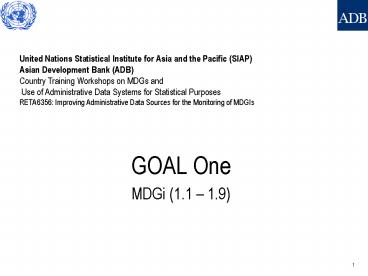GOAL One - PowerPoint PPT Presentation
1 / 33
Title:
GOAL One
Description:
Goal 1: Eradicate Extreme Poverty & Hunger. 12. 1.4 Growth rate of GDP per person employed ... Goal 1: Eradicate Extreme Poverty & Hunger. 22 ... – PowerPoint PPT presentation
Number of Views:20
Avg rating:3.0/5.0
Title: GOAL One
1
United Nations Statistical Institute for Asia and
the Pacific (SIAP) Asian Development Bank
(ADB) Country Training Workshops on MDGs and Use
of Administrative Data Systems for Statistical
Purposes RETA6356 Improving Administrative Data
Sources for the Monitoring of MDGIs
- GOAL One
- MDGi (1.1 1.9)
2
(No Transcript)
3
Headcount Index (P0)
- Definition
- Proportion/percentage of the population for whom
consumption (or other indicator of welfare) is
less than the poverty line - Computed as
Where q number of people below poverty
line N total population
4
Data for Mongolia
5
Poverty Gap (PG) and PG Ratio (P1)
- Poverty gap
- Average, over all people, of the gaps between
poor peoples living standards and the poverty
line - Indicates the average extent to which individuals
fall below the poverty line (if they do) - Poverty gap ratio
- Expresses the poverty gap as a percentage of the
poverty line
6
PG Ratio Mathematics
- Poverty gap ratio (P1) is
- Ratio of the Poverty Gap (PG) to the poverty line
(z) - PG expressed as a percentage of the line.
- Incidence x Poverty Gap
7
PG Ratio Example
- Assume poverty line z125. What is the poverty
gap index for the two countries?
8
Share of Consumption of the Poorest
- Definition Total consumption/income of the
poorest group, as a share of total
consumption/income in the population. - Where yi is per capita consumption/income
- N is the total population
- m is the number of individuals in the lowest x
.
9
MDGi (1.1-1.3) Comments
- Tips caveats
- Consumption data is usually used because of the
difficulties in collecting accurate income. - More information on expenditure, the higher it
tends to be. - Preferable to compute the 3 indicators from same
dataset
- Common difficulties
- Inconsistencies in data coverage (surveys collect
different baskets of goods at different
times)-comparability - Data quality
- Disaggregation to lower levels
10
Data for Mongolia
11
(No Transcript)
12
- Gross Domestic Product (GDP) per person employed.
- Represents labour productivity. i.e. the amount
of output (GDP) per unit of input (person
employed). - Computed as a ratio
- The numerator is the GDP,
- The denominator is the number of persons employed.
13
1.4 Growth rate of GDP per person employed
14
- Proportion of a countrys working-age population
that is employed. - Generally, computed as a ratio
- The numerator is the number of persons employed,
- The denominator is the population.
15
1.5 Employment-to-population ratio
16
- Gives a picture of the relationship between
poverty and employment. - Generally, computed as a ratio
- The numerator is the number of employed people
living below 1 (PPP) per day, - The denominator is the number of employed people.
17
1.6 Proportion of employed people living below
1 (PPP) per day
18
- Provides a measure of the share of vulnerable
employment. - Generally, computed as a ratio
- The numerator is the sum of
- number of own-account workers (self-employed
workers without employees), - number of contributing family workers (who hold
self-employment jobs in a market-oriented
establishment operated by a related person living
in the same household).
19
- Continued.
- The denominator is the number of employed people.
- Self-employment jobs are jobs where the
remuneration is directly dependent upon the
profits derived from the goods and services
produced.
20
1.7 Proportion of own-account and contributing
family workers in total employment
21
(No Transcript)
22
- Percentage of children under five whose weight
for age is less than minus two standard
deviations from the median for the international
reference population aged 0 to 59 months - The reference population adopted by the WHO in
1983 is based on children from the United States,
who are assumed to be well nourished (the
NCHS/WHO reference population).
23
- Key Concepts
- Child malnutrition, as reflected in body weight,
is selected as an indicator for several reasons.
- Monitored more closely than adult malnutrition
- Can affect health in later life
- May be taken as an indicator of malnutrition in
the population
24
- Method of Computation
- For each age group in the NCHS/WHO table of child
weights, the weights of national child population
are compared with the weights given in the table. - The percentages of children whose weights are
more than two standard deviations less than the
median are then aggregated to form the total
percentage of the children under 5 who are
underweight.
25
Data for Mongolia
26
more measures..
27
data for sub-populations
28
- Percentage of population whose food intake falls
below the minimum level of dietary energy
requirements - Prevalence of undernourishment
- Percentage of population that is undernourished
29
- Key Concepts
- Distribution of the dietary energy consumption
among the population - Considering total food availability and
inequality in access to food - Application of an estimated minimum for energy
requirements. - Measure of food insecurity
30
- Method of Computation
- Prepared by FAO at national level and aggregated
to get regional and global estimates - Distribution of dietary energy consumption is
modeled as lognormal function - Minimum energy requirement level or cut-off point
is estimated as a population per capita average
value
31
Mongolia targets for Goal-1
32
Mongolia target 3
33
Mongolia target 4































![[PDF] Neglected Zoonoses and Antimicrobial Resistance: Impact on One Health and Sustainable Development Goals Free PowerPoint PPT Presentation](https://s3.amazonaws.com/images.powershow.com/10082405.th0.jpg?_=202407200910)